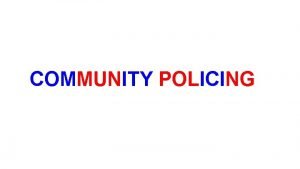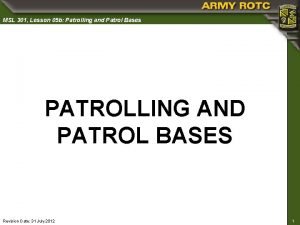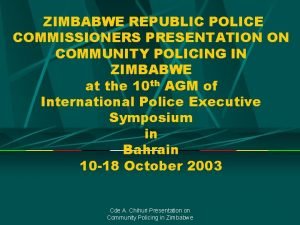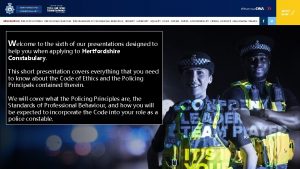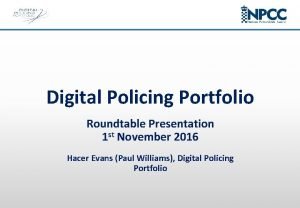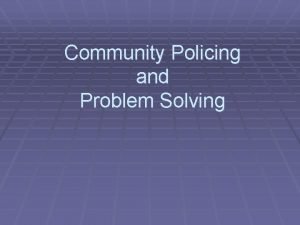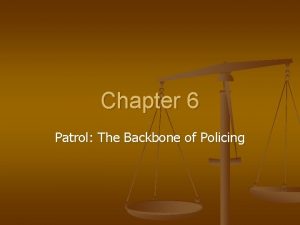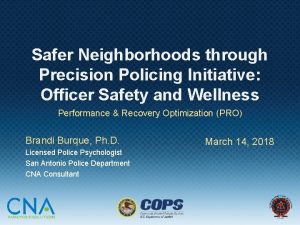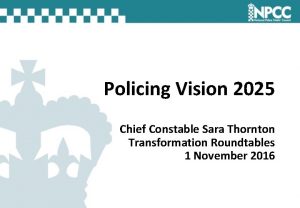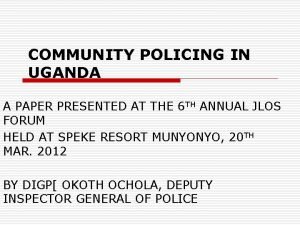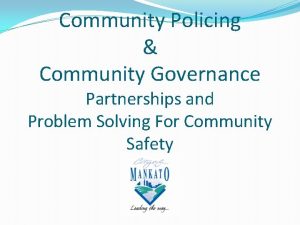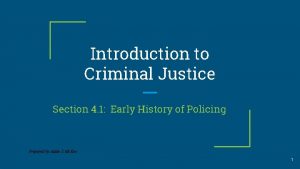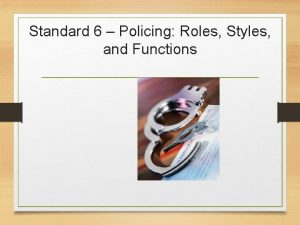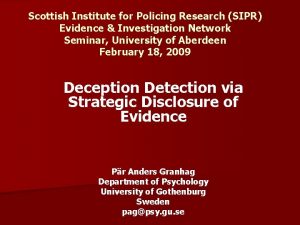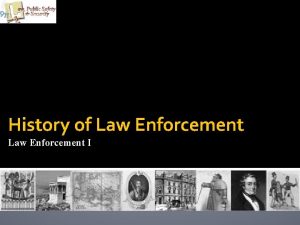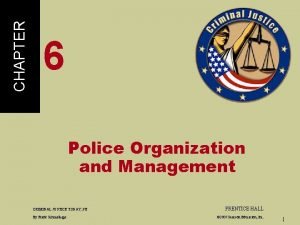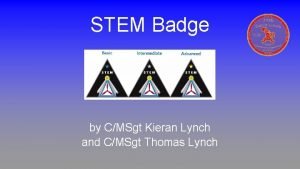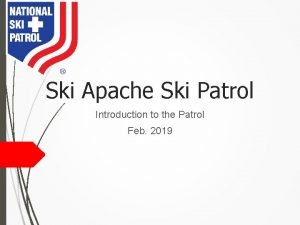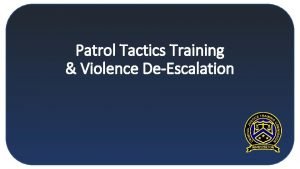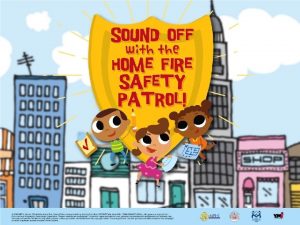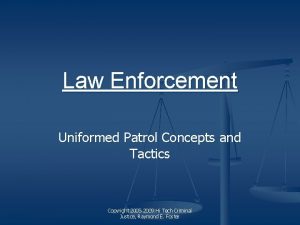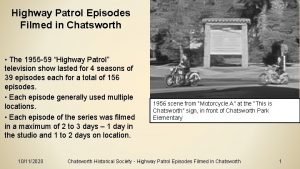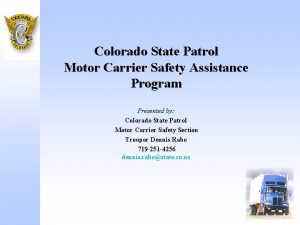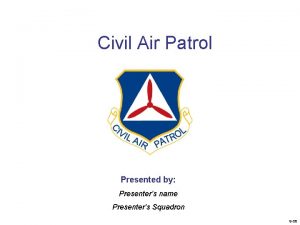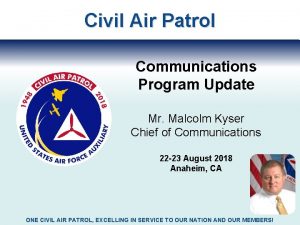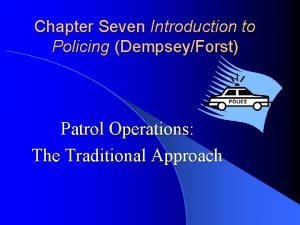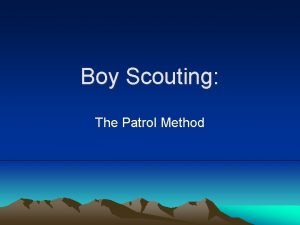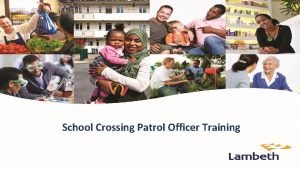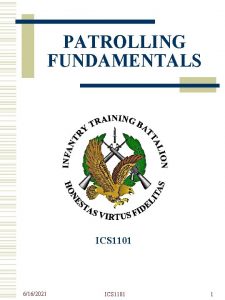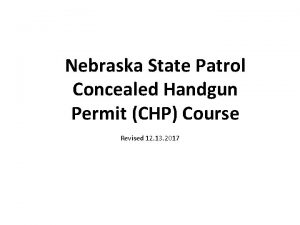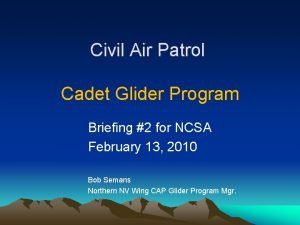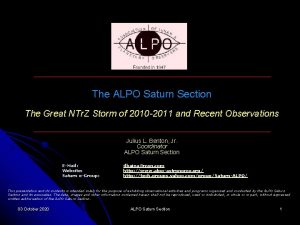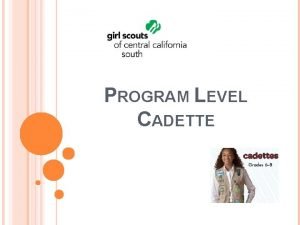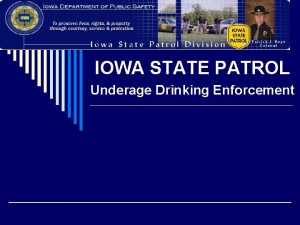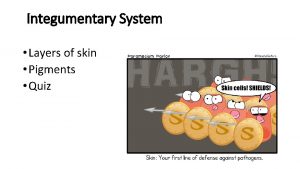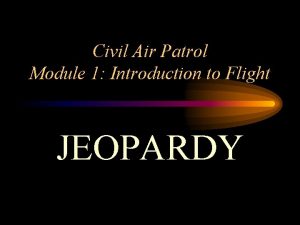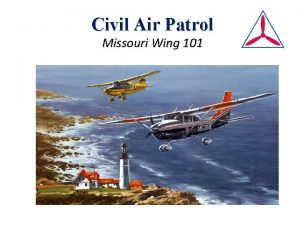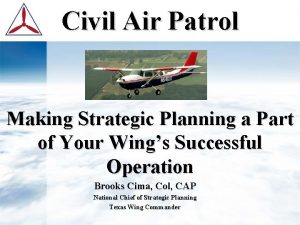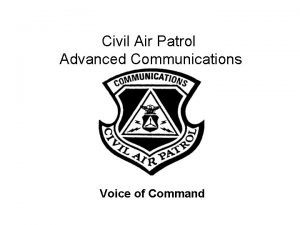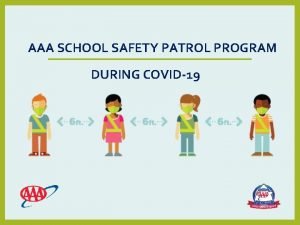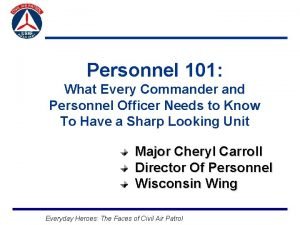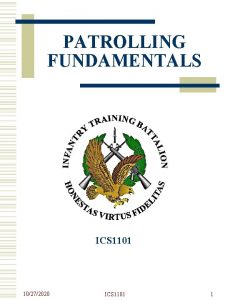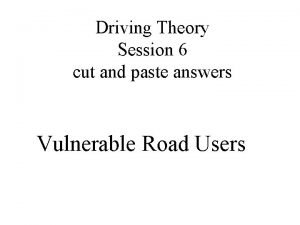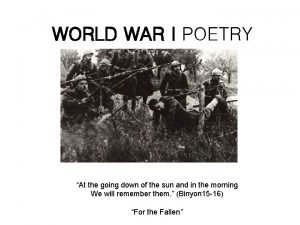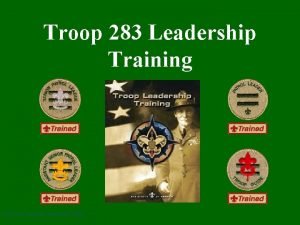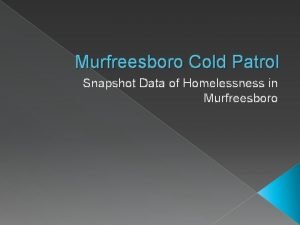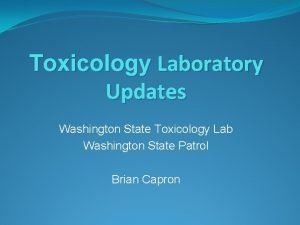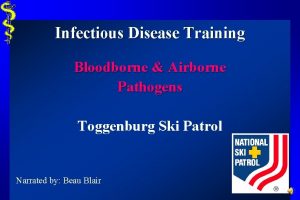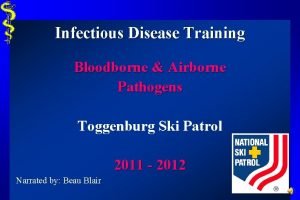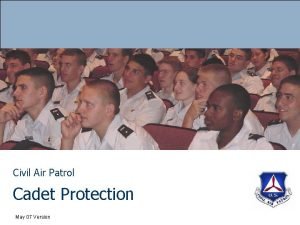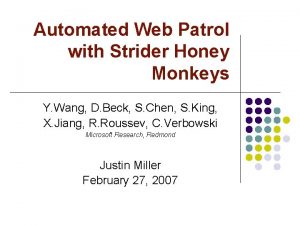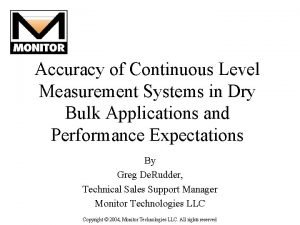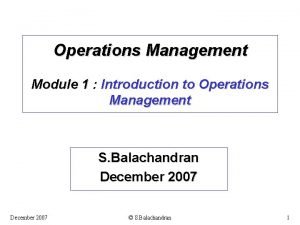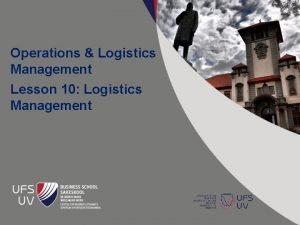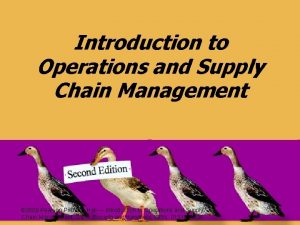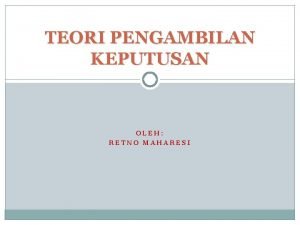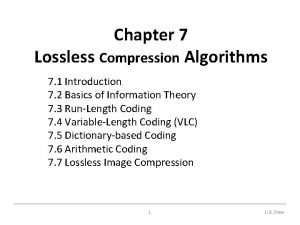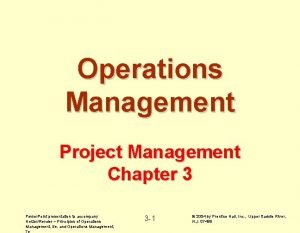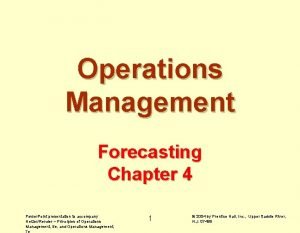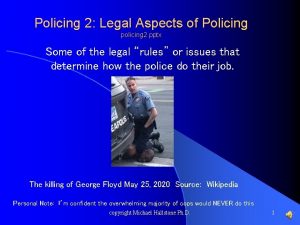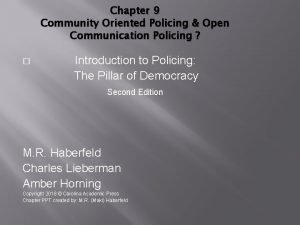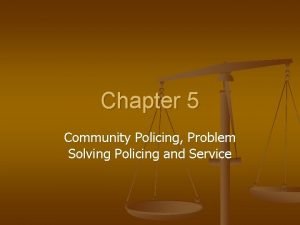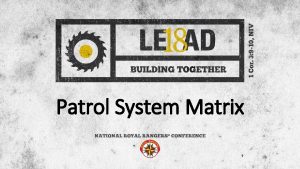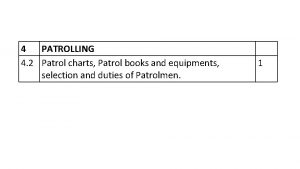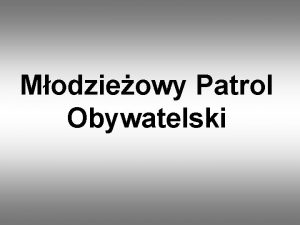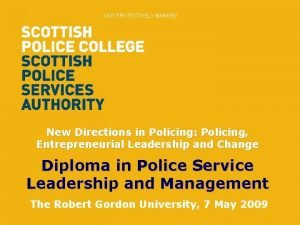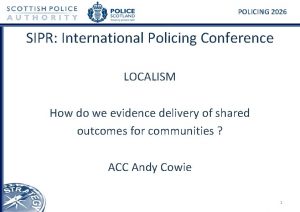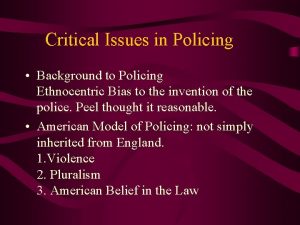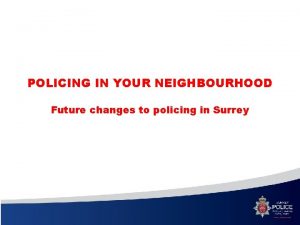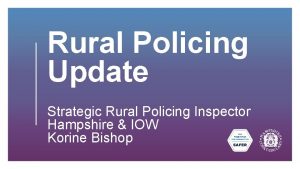Chapter Seven Introduction to Policing DempseyForst Patrol Operations








































































- Slides: 72

Chapter Seven Introduction to Policing (Dempsey/Forst) Patrol Operations: The Traditional Approach

The Traditional Patrol Method: Random a routine patrol (AKA preventative patrol) 2. Rapid response to citizens 911 calls 3. Retroactive investigation of past crimes by detectives (CID) 1. Unit 9: Patrol Operations Essential Question: What are the most effective ways to patrol an area? 2

Evaluating the Effectiveness of Patrol l. Does a high crime rate mean the police are ineffective? Unit 9: Patrol Operations Essential Question: What are the most effective ways to patrol an area? 3

The Kansas City Study: 1972 l Random police patrol was increased, remained the same, or eliminated in various areas throughout the city l First major study of patrol tactics l Results indicated patrol type did not have impact on crime l Found 50 percent of police officer time was uncommitted and could be used more effectively Unit 9: Patrol Operations Essential Question: What are the most effective ways to patrol an area? 4

Studies of Rapid Response: Quick response time does have some impact on crime solving l Three basic components: l 1. Time between crime and call to police 2. Dispatch time 3. Response time Unit 9: Patrol Operations Essential Question: What are the most effective ways to patrol an area? 5

Retroactive Investigation l Traditionally almost all felonies and some misdemeanors were investigated by CID l 93 percent of all CID effort was not productive l One study indicated half of all CID to be replaced without influencing a crime clearance rates l In single most important factor is information victim supplies to responding patrol Unit 9: Patrol Operations Essential Question: What are the most effective ways to patrol an area? 6

Question 1 Research about patrol tells us A) Half of police time was not being used well B) Response time has no impact of crime solving C) Most CID effort did not result in arrests D) Patrol crime scene processing was most important in solving crime E) A & C F) B & D Unit 9: Patrol Operations Essential Question: What are the most effective ways to patrol an area? 7

Activities of patrol officer

Samuel Walker 1829 Deterrence of crime 2. Maintaining feeling of public security 3. 24 -hour availability of service 1. Unit 9: Patrol Operations Essential Question: What are the most effective ways to patrol an area? 9

American Bar Association Deter crime maintaining visible presence 2. Maintaining public order 3. Quick response to violations or emergencies 1. Unit 9: Patrol Operations Essential Question: What are the most effective ways to patrol an area? 10

American Bar Association Identify and apprehend criminals 5. Aid individuals 6. Facilitate movement of traffic and people 7. Create a sense of security in the community 4. Unit 9: Patrol Operations Essential Question: What are the most effective ways to patrol an area? 11

0 W. Wilson l Thought police should give impression of omnipresence l Emphasize to the rational distribution of patrol officers according to workload formula l His writings were" Bible of policing" l Many things wrong and based on faulty assumptions Unit 9: Patrol Operations Essential Question: What are the most effective ways to patrol an area? 12

Gay, Schell and Schack defined patrol activity in the four categories: Calls for service 25 percent 2. Preventative patrol 40 percent 3. Officer initiated activities (tickets) 15 percent 4. Administrative task 20 percent 1. Unit 9: Patrol Operations Essential Question: What are the most effective ways to patrol an area? 13

Patrol Activity Studies: l Show that vast majority of police calls are not criminal in nature l Very few were violent crime Unit 9: Patrol Operations Essential Question: What are the most effective ways to patrol an area? 14

Patrol: l Two major deployments for patrol are motorized patrol and foot patrol l In the 1960 s and 1970 s foot patrols considered wasteful, at the time there were no portable radios l By the 1980 s virtually all police were vehicle patrol l Vehicle patrol has been criticized “a man in the car is isolated from the community" Unit 9: Patrol Operations Essential Question: What are the most effective ways to patrol an area? 15

Returned to Foot Patrol Foot patrol research indicates: 1. When foot patrols added levels of fear decreased 2. When patrol is withdrawn fear significantly increases 3. System satisfaction of police increases with the patrol 4. Police had more interaction with neighborhood residents 5. Foot patrol police have greater job satisfaction, Unit 9: Patrol Operations Essential Question: What aremorale the most effective ways to patrol an area? less fear, and higher 16

CID l Job to solve or clear reported crimes l Organized two ways centralized or decentralized – centralized all detectives operate a central office and specialized particular types of crime – decentralized detectives work out precinct and handle a variety of crime Unit 9: Patrol Operations Essential Question: What are the most effective ways to patrol an area? 17

Question 2 Foot Patrol: A) Decreased public fear B) Has no impact on fear C) Increases officer danger D) Reduced morale in officers E) Had a huge impact on crime Unit 9: Patrol Operations Essential Question: What are the most effective ways to patrol an area? 18

Detectives mystique l The idea that detective work as glamorous exciting and dangerous l In reality a majority of time is filling our reports and interviewing victims Unit 9: Patrol Operations Essential Question: What are the most effective ways to patrol an area? 19

Traffic operations 1. 2. 3. 4. 5. 6. Elimination of accidents Identification of traffic problems and hazards Regulation of parking Investigation of traffic accidents Public education (includes tickets) Arrest offenders Unit 9: Patrol Operations Essential Question: What are the most effective ways to patrol an area? 20

Special police operations l Swat - first was Philadelphia 1960 s l Today about 90 percent of police agencies have a paramilitary unit Unit 9: Patrol Operations Essential Question: What are the most effective ways to patrol an area? 21

Emergency service units l Increasingly popular l Often merges with fire department l Services include search and rescue, Haz. Mat, bomb squad, and other first responder services Unit 9: Patrol Operations Essential Question: What are the most effective ways to patrol an area? 22

Chapter Eight Introduction to Policing (Dempsey/Forst) Patrol Operations: A New Approach

Alternatives to Traditional Patrol l Directed patrol-officers are given specific duties when not responding to calls – Assignments based on crime analysis, specific problems, or complaints – Proven very effective Unit 9: Patrol Operations Essential Question: What are the most effective ways to patrol an area? 24

Alternatives to Traditional Patrol l Split force patrol-one portion of patrol force handles dispatch goals the other are on directed patrol – Also proven very effective especially in improved productivity Unit 9: Patrol Operations Essential Question: What are the most effective ways to patrol an area? 25

Alternatives to Traditional Patrol l Differential response to calls for service-not all calls for service to 911 are responded to by police – Rated for importance or severity – Less serious calls are handled alternative methods Unit sent later l Report taken at precinct l Report taken by nonsworn officer l Appointment made for reportedly taken l Unit 9: Patrol Operations Essential Question: What are the most effective ways to patrol an area? 26

Alternatives to Traditional Patrol l Differential response to calls for service – While research indicates effectiveness improves community dissatisfaction is a possibility – Allocation of natural resources should depend on effectiveness not public relations Unit 9: Patrol Operations Essential Question: What are the most effective ways to patrol an area? 27

Alternatives to Traditional Patrol l Managing Criminal Investigations(MCI) – Expands role of patrol officers to include investigative responsibilities Handles follow-up l Locating interviewing victims and witnesses l Detecting evidence l Prepares initial investigative report l – Designing a new method to manage investigations using a screening method l Solvability factors Unit 9: Patrol Operations Essential Question: What are the most effective ways to patrol an area? 28

Alternatives to Traditional Patrol l Managing Criminal Investigations(MCI) – Grading based according to solve ability Is there a witness l Is suspect known l Can suspect the identified l Is victim cooperative l – MCI allows investigators to put more time and effort into very important cases Unit 9: Patrol Operations Essential Question: What are the most effective ways to patrol an area? 29

Alternatives to Traditional Patrol la small number of criminals are responsible for most of predatory street from the U. S. l Repeat offender programs (ROPS) l First police identify criminals that maintain surveillance and attend to catch the criminal in the act l Second they use case enhancement to ensure proper handling of the offender by the criminal justice system. Unit 9: Patrol Operations Essential Question: What are the most effective ways to patrol an area? 30

Alternatives to Traditional Patrol l Case Enhancement – a liaison is established with the district attorney’s office to alert the importance of the case coming from a career criminal. This assures zealous efforts by the prosecutor and maximum sentencing by the judge. Unit 9: Patrol Operations Essential Question: What are the most effective ways to patrol an area? 31

Question 3 Driving around being intentionally non-intential is called: A) Directed patrol B) Split Force C) Differential D) Random/preventative Unit 9: Patrol Operations Essential Question: What are the most effective ways to patrol an area? 32

New, Proactive Techniques l Uniformed tactical operations-officers are relieved from traditional patrol responsibilities to concentrate on proactive crime control. Units often saturated area experiencing crime problems, make numerous pedestrian and vehicle stops, and make numerous field interrogations. Unit 9: Patrol Operations Essential Question: What are the most effective ways to patrol an area? 33

New, Proactive Techniques l Field interrogations (FI) – a contact with a citizen initiated by a patrol officer who stops, questions, and sometimes searches because the officer has a reasonable suspicion that subject may have committed, or maybe committing, or about to commit a crime. Unit 9: Patrol Operations Essential Question: What are the most effective ways to patrol an area? 34

New, Proactive Techniques l Aggressive patrol tactics-uniform tactical operations use this tactic where they stop numerous people and vehicles attempt to discover evidence of crime. – Often causes community unrest and charges of citizen’s rights violations – Used highly effectively in the 1990 s in New York City in addition with zero tolerance policies. Even minor offenders were frisked and checked. While crime rates plummeted tensions between the minority community and the New York police skyrocketed. Unit 9: Patrol Operations Essential Question: What are the most effective ways to patrol an area? 35

New, Proactive Techniques l Saturation patrol - another uniform tactical operations utilizing a larger number of uniform officers than normal to a particular area to deal with particular crime – Also highly effective Unit 9: Patrol Operations Essential Question: What are the most effective ways to patrol an area? 36

New, Proactive Techniques l Decoy operations: – Blending-officers dressed in civilian clothes to blend into an area or in and unmarked car – Decoy-officers stress and play the role of potential victims or as a fellow criminal l Most effective in larceny investigations Unit 9: Patrol Operations Essential Question: What are the most effective ways to patrol an area? 37

New, Proactive Techniques l Stakeout operations: – A group of heavily armed officers waiting for anticipated crime to occur usually a robbery l Sting operations: – Major technique used in recent years using various undercover methods to apprehend criminals usually involved in burglaries and thefts – Example-pawn shop run by undercover officers that buys stolen property Unit 9: Patrol Operations Essential Question: What are the most effective ways to patrol an area? 38

New, Proactive Techniques l Code enforcement-a method whereby police, fire, building, and zoning departments work together to address crime areas usually crack houses l Efforts against drunk drivers-usually utilize checkpoints or roadblocks – Often used to detect other crime Unit 9: Patrol Operations Essential Question: What are the most effective ways to patrol an area? 39

New, Proactive Techniques l Undercover operations-where an investigator assumes a different identity to obtain information. – Used a lot by police both locally federally and increasingly by private security l Shrinkage-term used to describe the difference between inventory on hand inventory on paper. Usually shrinkage occurs through employee theft and shoplifting. Unit 9: Patrol Operations Essential Question: What are the most effective ways to patrol an area? 40

New, Proactive Techniques l Entrapment-defined as inducing an individual to commit a crime he or she did not contemplate for the sole purpose of criminal prosecution – Jacobsen vs. the United States, 1992 -limits the extreme use of entrapment. It established: officer should be able to articulate legitimate law enforcement purpose l Avoid using persistent or coercive techniques l Officer should be able to demonstrate the defendant was disposed to commit the criminal act prior to government involvement l Unit 9: Patrol Operations Essential Question: What are the most effective ways to patrol an area? 41

Question 4 Using multiple undercover methods to target larceny: A) Aggressive Patrol B) Saturation Patrol C) Decoy Operations D) Sting Operations E) Stakeout Operations F) Code Enforcement Unit 9: Patrol Operations Essential Question: What are the most effective ways to patrol an area? 42

Traffic Stops Unit 9: Patrol Operations All Images © Microsoft Corporation Essential Question: What are the most effective ways to patrol an area? 43

5 Reasons for Vehicle Contacts 1. 2. 3. 4. 5. Issue citation Issue warning Aid motorist Investigate suspicious vehicle Investigate suspected criminal activity unrelated to vehicle Unit 9: Patrol Operations Essential Question: What are the most effective ways to patrol an area? 44

Wash’s Rule of Traffic Stops There is ALWAYS inherent risk in any contact Unit 9: Patrol Operations Essential Question: What are the most effective ways to patrol an area? 45

Objectives of Vehicle Contact 1. To protect yourself and others 2. To protect property, vehicles 3. To ensure due process 1. Clearly ID self as officer 2. Verbally notify of suspected offense 3. Advise rights Unit 9: Patrol Operations Essential Question: What are the most effective ways to patrol an area? 46

Most important thing: ALWAYS call in license plate, location of stop, and other information to dispatch Unit 9: Patrol Operations Essential Question: What are the most effective ways to patrol an area? 47

Pull Over Placement • Choose good stop position – Consider: • • Lighting Traffic hazard Environmental hazards Interference by spectators – Have car move if necessary Unit 9: Patrol Operations Essential Question: What are the most effective ways to patrol an area? 48

Wash’s nd 2 Rule • If you think you need back up – call for it and wait. “Discretion is the better part of valor” Unit 9: Patrol Operations Essential Question: What are the most effective ways to patrol an area? 49

Vehicle Positions • Inline – use in narrow space – All lights on Unit 9: Patrol Operations Essential Question: What are the most effective ways to patrol an area? 50

Vehicle Positions • Off-Set – use in wide space – Offers safe path to other vehicle Unit 9: Patrol Operations Essential Question: What are the most effective ways to patrol an area? 51

Vehicle Positions • Left Angle – use in wide space – Offers safe path to other vehicle – Offers Cover – Limits use of light for concealment Unit 9: Patrol Operations Essential Question: What are the most effective ways to patrol an area? 52

Approach Concerns: • Concealment vehicles: vans, rvs • Multiple occupants • Vehicle believed to be leaving any crime • Suspicious behavior Unit 9: Patrol Operations Essential Question: What are the most effective ways to patrol an area? 53

Approach Concerns: • Options: – Bring driver back to you – Use back up Unit 9: Patrol Operations Essential Question: What are the most effective ways to patrol an area? 54

Driver Side Approach: • • • Most common Convenient Limits escape options Immediate access to driver – DUI Dangerous traffic – more likely to be hurt by other car than driver Unit 9: Patrol Operations Essential Question: What are the most effective ways to patrol an area? 55

Tactical Driver Side Approach: • Off set vehicle • Allows for you to see driver from their mirror but they cannot see you Unit 9: Patrol Operations Essential Question: What are the most effective ways to patrol an area? 56

Passenger Side Approach: • Big element of surprise • Go around back of own car • Increased cover and escape options for officer • Decreases driver contact • Dangerous to reach across car Unit 9: Patrol Operations Essential Question: What are the most effective ways to patrol an area? 57

Bringing Driver Back: • • Increasingly popular You can order passengers back as well Maximizes view Limits concealment Easy weapon access for officer Psychological advantage Separates the driver from the passengers Puts driver in harms way - DUI Unit 9: Patrol Operations Essential Question: What are the most effective ways to patrol an area? 58

Do’s and Don'ts • • Be aware of other threats Keep gun hand free Don’t close or lock door Have occupants keep hands where you can see them • Check trunk • Stay in blind spot, use cover of lights • Use flashlight to view interior Unit 9: Patrol Operations Essential Question: What are the most effective ways to patrol an area? 59

Do’s and Don’ts • • Stay behind door Have them hand license out to you Explain everything Ask “Is there a lawful reason you were…” Walk back keep - attention on occupants Tickets – don’t take eye off car Return the same way NEVER REACH IN CAR Unit 9: Patrol Operations Essential Question: What are the most effective ways to patrol an area? 60

Do’s and Don’ts • DON’T say “have a nice day!” (may be taken wrong) try “drive safe” • Night time: – Do not cross headlights – Flashlight in weak hand Unit 9: Patrol Operations Essential Question: What are the most effective ways to patrol an area? 61

High Risk Contacts • Once called “felony stops” • Factors: – High potential for bodily harm – Greater threat to public safety – Arrest needs heavy control of subjects Unit 9: Patrol Operations Essential Question: What are the most effective ways to patrol an area? 62

Vehicle Positions • High Risk Unit 9: Patrol Operations Essential Question: What are the most effective ways to patrol an area? 63

High Risk Contacts • 3 Important Objectives: – Communication – Coordination – Control Unit 9: Patrol Operations Essential Question: What are the most effective ways to patrol an area? 64

Communication • CYMBLE • • • Color Year Make Body License Equipment • Radio all possible relevant info • Be sure to CONSTANTLY communicate to other officers Unit 9: Patrol Operations Essential Question: What are the most effective ways to patrol an area? 65

Coordination • • Do not approach alone Contact Officer: controls contact Cover Officer: keeps eyes on car Arrest Officer: searching, interviewing and cuffing • Traffic Officer: maintains perimeter • Forward Observer: avoids crossfire and provides 411 (optional position) Unit 9: Patrol Operations Essential Question: What are the most effective ways to patrol an area? 66

Control • • Coordinate efforts before starting 35 -50 ft distance Use proper techniques – cuffing, etc. Clear, consistent, & concise communication • Verbalize specific commands • Use appropriate level of force Unit 9: Patrol Operations Essential Question: What are the most effective ways to patrol an area? 67

Clear Vehicle • On approach assume “plus one” mentality • Options for dealing with occupant refusing to cooperate – – – Time/wait Talk/bluff Negotiations Call tactical/SWAT Tactical approach Unit 9: Patrol Operations Essential Question: What are the most effective ways to patrol an area? 68

Question 5 The reason we no longer call High Risk Pullovers "Felony Stops" is because A) Even a pullover for a minor infraction can result in a deadly outcome B) Officers didn't recognize the danger of typical traffic stops C) Any pullover may involve a person who has committed a serious crime unknown to the officer D) All of the above E) None of the above Unit 9: Patrol Operations Essential Question: What are the most effective ways to patrol an area? 69

Lab • Each person will rotate through positions of team • Others will remain quiet, pay attention and behave! • RPD is a BIG supporter of program – you must make a good impression! • LAB GRADE: team will deal with unknown and be evaluated. They will also write a police report on situation. Unit 9: Patrol Operations Essential Question: What are the most effective ways to patrol an area? 70

Grade • Police Reports – All forms – Complete narrative – if you die, write up until death – Due NEXT day! • Practicum grade based on good mechanics, techniques and GROUP INTERACTION! • Lab grade is BIG part of final grade – Do a good job! Unit 9: Patrol Operations Essential Question: What are the most effective ways to patrol an area? 71

Traffic Stops Unit 9: Patrol Operations Essential Question: What are the most effective ways to patrol an area? 72
 Introduction of community policing
Introduction of community policing Priorities of work patrol base
Priorities of work patrol base Chapter 5 policing history and structure
Chapter 5 policing history and structure Community policing in zimbabwe
Community policing in zimbabwe 9 policing principles code of ethics
9 policing principles code of ethics Digital policing portfolio
Digital policing portfolio Community policing
Community policing Backbone of policing
Backbone of policing Traditional policing meaning
Traditional policing meaning Snppi
Snppi Police vision 2025
Police vision 2025 Community policing in uganda
Community policing in uganda Community governance definition
Community governance definition Kin policing
Kin policing Backbone of police organization
Backbone of police organization Policing styles
Policing styles Scottish institute for policing research
Scottish institute for policing research Pharaoh hur moheb
Pharaoh hur moheb Routine incident response
Routine incident response The seven heavenly virtues
The seven heavenly virtues Introduction to operations management chapter 1
Introduction to operations management chapter 1 Capp 60-41
Capp 60-41 Ski apache web
Ski apache web Patrol tactics training
Patrol tactics training Home fire safety patrol
Home fire safety patrol Split force patrol
Split force patrol Highway patrol television show season 1
Highway patrol television show season 1 Colorado state patrol motor carrier safety
Colorado state patrol motor carrier safety Civil air patrol national conference
Civil air patrol national conference Malcolm kyser
Malcolm kyser Split force patrol
Split force patrol Boy scout patrol method
Boy scout patrol method Civil air patrol kahoot
Civil air patrol kahoot Nissan patrol vibration problems
Nissan patrol vibration problems School crossing patrol winter coat
School crossing patrol winter coat Ics patrol
Ics patrol Nebraska state patrol concealed carry
Nebraska state patrol concealed carry Patrol totem
Patrol totem Civil air patrol glider
Civil air patrol glider Opqrst sample
Opqrst sample Civil air patrol model rocketry badge
Civil air patrol model rocketry badge Preopposition
Preopposition Girl scout patrol system
Girl scout patrol system Iowa state patrol districts
Iowa state patrol districts Layers of skin quiz
Layers of skin quiz Civil air patrol aerospace module 1
Civil air patrol aerospace module 1 Missouri wing civil air patrol
Missouri wing civil air patrol Civil air patrol strategic plan
Civil air patrol strategic plan Civil air patrol frequencies
Civil air patrol frequencies Aaa safety patrol supplies
Aaa safety patrol supplies Civil air patrol powerpoint template
Civil air patrol powerpoint template Semiotics
Semiotics All personnel officers
All personnel officers Ics patrol
Ics patrol At night you see a pedestrian wearing reflective
At night you see a pedestrian wearing reflective Cessna 172m cockpit
Cessna 172m cockpit At the going down of the sun poem
At the going down of the sun poem National honor patrol award
National honor patrol award Murfreesboro cold patrol
Murfreesboro cold patrol Wsp toxicology lab
Wsp toxicology lab Toggenburg ski patrol
Toggenburg ski patrol Toggenburg ski patrol
Toggenburg ski patrol Cadet protection policy
Cadet protection policy Web patrol
Web patrol Monitor silo patrol
Monitor silo patrol Seven segment display introduction
Seven segment display introduction Operations management modules
Operations management modules Introduction to operations and supply chain management
Introduction to operations and supply chain management Introduction to operations and supply chain management
Introduction to operations and supply chain management Contoh kriteria laplace
Contoh kriteria laplace Chapter seven
Chapter seven Operations management chapter 3 ppt
Operations management chapter 3 ppt Operations management chapter 4 forecasting solutions
Operations management chapter 4 forecasting solutions
